Table of Contents
An Overview of Risk-Adjusted KPIs
7-Steps to Implement Risk-Adjusted KPIs
- Step 1: Review Strategic Objectives and Quantify KPIs
- Step 2: Review Your Risk Appetite Annually
- Step 3: Review and Update Relevant Risks
- Step 4: Map Risks to KRIs
- Step 5: Enrich KPIs with Data and KRIs
- Step 6: Monitor Performance and Refine Strategies
- Step 7: Reporting and Notifications
Common Challenges for KRI-adjusted KPI Adoption and How to Overcome Them
Explore Our Related Guides
Introduction
Key Performance Indicators (KPIs) empower executives, managers, and stakeholders to assess performance and track progress toward strategic goals. These metrics provide the foundation for evaluating organizational success.
However, many businesses struggle to leverage the potential of KPIs fully. Without enhancement through predictive analytics, KPIs remain backward-looking, offering only historical snapshots of past performance.
A major challenge is that KPIs are often scattered across siloed systems—CRMs for sales, marketing automation tools, ERP, and accounting systems. As a result, consolidating and transforming this data into a unified view that is actionable for executives and the board of directors becomes a daunting task. Even when data is finally aggregated, it quickly becomes outdated, compounding the problem.
To truly anticipate future performance, KPIs must incorporate risk perspectives. Risk metrics, such as Key Risk Indicators (KRIs), are frequently stored in disconnected systems like spreadsheets, ERM software, or GRC platforms. This guide highlights a key dimension of KPI enhancement: risk-adjusted KPIs, which many organizations can implement using their existing systems.
Traditional KPIs have been the cornerstone of performance measurement in mid-sized organizations for years. Yet, as today’s business landscape grows more complex and unpredictable, companies must evolve by integrating risk and predictive analytics into their KPIs. Enriched KPIs offer a powerful way to gauge performance, blending data analytics, predictive models, and risk assessments to provide a more nuanced view of business outcomes.
Mid-market organizations need the right systems and talent to gain real-time insights from predictive KPIs. Technologies like data warehouses and data lakes can consolidate this data, while data engineers and analysts can build the necessary dashboards and reports. Unlike larger corporations, mid-market organizations often face resource constraints in talent and systems, making it difficult to keep pace in competitive markets.
This guide explores the transformative power of enriched KPIs, offering a roadmap for mid-market organizations to enhance their performance measurement. By embracing advanced, data-driven metrics, companies can obtain a holistic, real-time view of their performance, ensuring they stay aligned with strategic objectives while managing risks effectively.
The guide outlines the benefits of implementing risk-adjusted KPIs and discusses a step-by-step method for integrating these metrics into the organization’s performance measurement framework. It explores the importance of top leadership’s commitment to applying a controllership lens, balancing decision-making with risk considerations.
Several practical insights and real-world examples are considered to help businesses navigate the complexities of risk-adjusted KPIs. It is critical to utilize technology, particularly AI, and recognize the challenges organizations may face in implementing risk-adjusted KPIs.
An Overview of Risk-Adjusted KPIs
Mid-market businesses face an increasingly complex and dynamic environment. Traditional performance measurement practices and tools are no longer enough. Risk-adjusted KPIs offer a more forward-looking approach, integrating risk management into the heart of strategic performance evaluation. Exploring the foundational aspects of risk-adjusted KPIs, their benefits, and practical application examples can help medium-sized organizations reshape how they measure success.
Understanding Risk-Adjusted KPIs
Risk-adjusted KPIs incorporate risk factors into evaluating business performance, providing a more comprehensive view of an organization’s achievements and challenges. Unlike traditional KPIs – which focus solely on outcomes – risk-adjusted KPIs also account for the potential risks associated with achieving or falling short of key targets. This dual perspective enables business organizations to align their performance measurement with risk management strategies and see where risks may prevent successful outcomes.
Why Risk-Adjusted KPIs Matter
Risk-adjusted KPIs offer several advantages over traditional KPIs:
- Predictive Performance Measurement: When businesses consider risk with performance management, their KPIs provide a clearer picture of potential achievement, emerging threats, and potential opportunities.
- Alignment with Risk Management: Risk-adjusted KPIs ensure organizational performance targets synchronize with risk appetite. This can guide the management in avoiding riskier decisions outside their risk-taking threshold, ensuring that growth objectives are sustainable.
- Support for Strategic Goals: Risk-adjusted KPIs allow organizations to align their risk management function and activities with broader strategic objectives, enabling organizations to achieve their goals while managing risk with greater control.
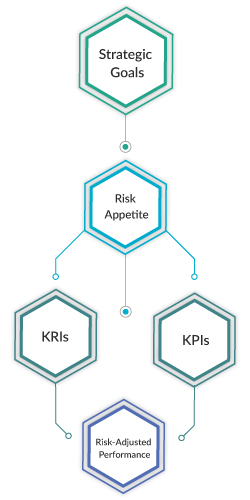
Benefits of Implementing Risk-Adjusted KPIs
Implementing risk-adjusted KPIs offers several clear advantages by aligning objectives with potential risks.
Enhanced Decision Making
Risk-adjusted KPIs simplify decision-making. Leaders gain better insights, allowing them to make more strategic choices when evaluating alternatives. By understanding the risks tied to performance outcomes, they can weigh potential benefits against drawbacks, leading to more informed decisions.
Balanced Performance Measurement
Risk-adjusted KPIs enable organizations to balance performance targets with risk considerations. This ensures that short-term goals aren’t pursued at the cost of long-term stability. Incorporating risk into performance planning allows businesses to achieve objectives without exposing themselves to unnecessary risks.
Regulatory Compliance
In a highly regulated environment, risk-adjusted KPIs play a crucial role in maintaining compliance. By integrating regulatory risks into performance measurement, organizations demonstrate responsible risk management, strengthening credibility with regulators.
Stakeholder Confidence
Trust from stakeholders—investors, regulators, customers, and employees—is vital for any business. Risk-adjusted KPIs offer transparency into performance and risk management. Prioritizing risk accountability builds confidence and reinforces the company’s reputation as a reliable and responsible organization.
Real-World Use-Case for Banks and Financial Institutions
Consider a $15 billion financial institution with extensive operations across multiple states within the USA. The bank may offer services such as retail banking, corporate finance, investment banking, and asset management.
Given its scale of operations and complexity, this bank would be well-positioned to benefit from implementing risk-adjusted KPIs.
There are three key areas where the bank would benefit the most.
- Enhanced Risk Management
Risk-adjusted KPIs are based on potential risks and integrated into performance metrics. This gives decision-makers a more comprehensive view of the bank’s operational and financial health.
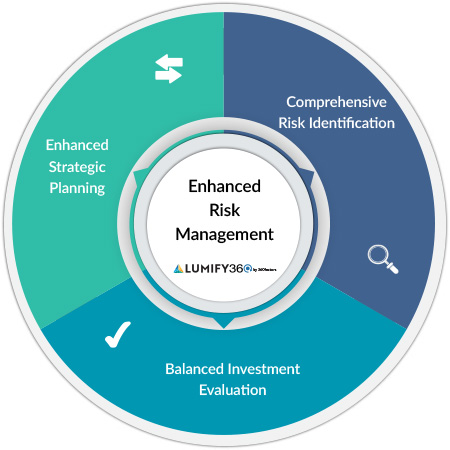
- Comprehensive Risk Identification: By adjusting KPIs for risk factors such as credit risk, market volatility, and regulatory compliance, banks can proactively identify areas of potential vulnerability and take preemptive action.
- Balanced Investment Evaluation: Risk-adjusted KPIs enable banks to have a more balanced performance evaluation by considering investment returns and associated risks. This ensures that growth targets are achieved without exposing the bank to too much risk.
- Enhanced Strategic Planning: A better understanding of risk-adjusted performance allows financial institutions to make informed strategic decisions that align with their risk appetite and long-term goals.
- Improved Capital Allocation
Integrating risk into performance metrics enables banks to optimize capital allocation as it allows them to consider risk-adjusted returns instead of absolute returns alone.
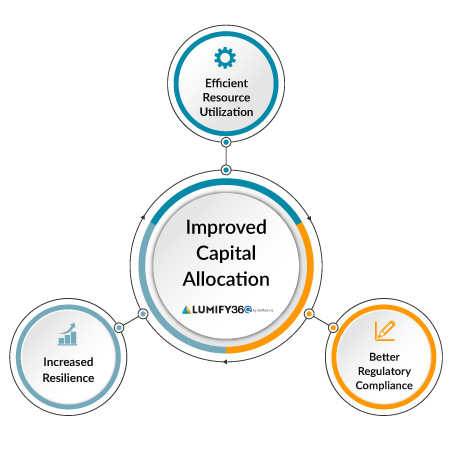
- Efficient Resource Utilization: Risk-adjusted KPIs allow banks to allocate capital more effectively, prioritizing projects and investments with favorable risk-return profiles, ultimately maximizing shareholder value.
- Better Regulatory Compliance: Aligning capital allocation with regulatory requirements and internal risk thresholds helps banks stay compliant while pursuing growth opportunities in competitive markets.
- Increased Resilience: Risk-aware capital allocation improves protection against economic downturns and market disruptions, enabling banks to maintain stronger capital buffers and financial stability.
- Boost Stakeholder Confidence
Risk-adjusted KPIs provide greater transparency in a bank’s decision-making, reinforcing stakeholder confidence and demonstrating effective risk management.
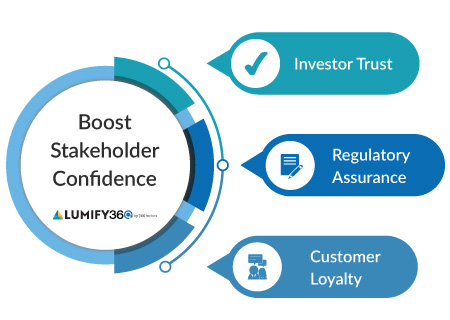
- Investor Trust: Investors and depositors gain confidence in the bank’s ability to handle risks, leading to easier access to capital and potential improvements in stock performance.
- Regulatory Assurance: Regulators, are more likely to view risk-adjusted banks as stable and compliant, reducing the chances of regulatory scrutiny.
- Customer Loyalty: Customers are more likely to trust banks with robust risk-adjusted performance metrics, leading to stronger, long-term relationships and increased loyalty.
In conclusion, risk-adjusted KPIs provide mid-sized businesses with a more accurate, balanced, and strategic approach to performance measurement, driving long-term success in a competitive and dynamic environment.
7 Steps to Implement Risk-Adjusted KPIs
Risk-adjusted KPIs provide a better understanding of how potential risks can impact an organization’s strategic goals and long-term plans. They improve decision-making, which ultimately leads to success for business organizations.
Implementing risk-adjusted KPIs successfully is not a simple task. Organizations must follow a systematic approach and consider major factors that involve risks and performance. Below is a detailed outline that can be useful for professionals to implement risk-adjusted KPIs successfully.
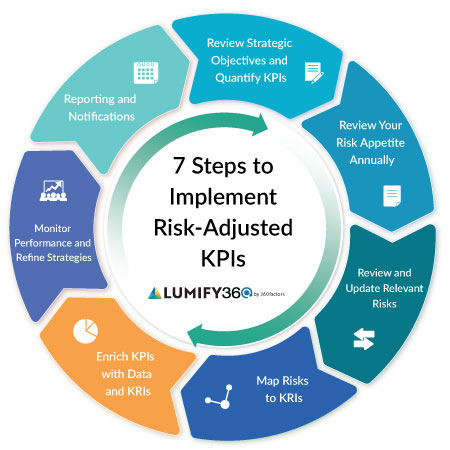
Step 1: Review Strategic Objectives and Quantify KPIs
Businesses must review their strategic objectives and quantify KPIs to help them align enriched KPIs with strategic organizational goals. Reviewing objectives in this step enhances the framework for businesses to determine how data analytics and risks should be integrated into their performance metrics.
Some of the key actions in this step are listed below.
- Improve Objective Hierarchy: Business objectives must be condensed into a priority list, from high-level strategic goals to specific operational targets. This hierarchy can immensely help align enriched KPIs with broader organizational goals.
- Align Objectives with Risks: Analysis may reveal a need to adjust and revise objectives to align with the organization’s risk appetite and tolerance levels. This is a critical step because alignment ensures that risk considerations are integrated into every evaluation of business performance.
- Set Data-Driven Objectives: Businesses should establish mechanisms to align predictive analytics with their strategic goals. For instance, consider a scenario where sales grew by 10% in the previous year alongside an economic growth rate of 3%. If the predicted economic growth rate for the following year is 5%, the sales growth target might reasonably be adjusted upwards. However, this adjustment should also account for other influencing factors, such as competitive pressures, changes in consumer demand, and potential market share gains. For example, based on these additional variables, the sales growth KPI could be set at 12–14%, reflecting a more strategic approach that evaluates additional market data.
Step 2: Review Your Risk Appetite Annually
Effective risk assessment and management are critical to the success of any business, yet small and medium-sized enterprises often overlook them. Due to their entrepreneurial nature, smaller organizations typically take on more risk, which can drive growth and increase the likelihood of failure. According to 2024 data from the U.S. Bureau of Labor Statistics, 20.4% of businesses fail in their first year, 49.4% fail in their first five years, and 65.3% fail in their first ten years.
For mid-sized organizations aiming for sustained growth, developing and regularly reviewing a clear risk appetite statement is crucial. This statement should define the types and levels of risk the business is prepared to assume in pursuit of its strategic objectives. A well-crafted risk appetite statement guides decision-making and ensures that the organization’s risk-taking is aligned with its capacity to manage and mitigate those risks in a competitive market environment.
- Communicate Across All Levels: Ensure that the risk appetite statement is communicated across all levels of the organization, aligning leadership, management, and operational teams around a common understanding of risk tolerance.
- Set Risk Boundaries: Define specific thresholds for various risk categories, such as credit, market, operational, and compliance risks. These thresholds help manage and control risk exposure, ensuring risk levels remain within acceptable limits.
- Flexible Adjustment: Ensure that risk thresholds are dynamic and can be adjusted to changes in the business environment, regulatory landscape, or strategic direction.
- Monitor and Report: Regular risk threshold review ensures they remain relevant and aligned with the organization’s risk appetite. A process should be set up for monitoring and reporting risk appetite changes, including the frequency, methodology, and procedures for expanding and contracting the limits.
Step 3: Review and Update Relevant Risks
Once strategic objectives and risk appetite have been updated, businesses need to identify the relevant risks they face. These include internal operational weaknesses and external threats that can impact the organization. Businesses must regularly analyze internal and external risks that could affect operations and hinder achieving strategic goals.
The following actions are critical in the identification of risks:
- Conduct a Risk Inventory: Outline an inventory of all the possible risks that your organization might face. This includes financial, operational, strategic, compliance, environmental, and reputational risks, among others.
- Use Risk Assessment Techniques: Employ best practices, such as Risk Control Self-Assessment (RCSA), Dynamic Risk Assessment (DRA), and Failure Mode and Effects Analysis (FMEA) to identify and evaluate risks systematically.
- Prioritize Risks: Once risks have been identified, they should be categorized based on their severity, likelihood of occurrence, and impact on the organization. Tools like a risk heat map can be useful in visualizing and prioritizing these risks.
Step 4: Map Risks to KRIs
Key Risk Indicators (KRIs) provide early warning signals of increasing risk exposures in various areas, such as credit risk, operational risk, market risk, and compliance risk. Developing KRIs ensures that the risks identified in step 3 can be aligned with the bank’s strategic objectives.
Some guidelines for selecting and monitoring relevant KRIs include the following.
- Account for Identified Risks: Develop KRIs that align with identified risks and reflect the organization’s risk appetite. Having KRIs in place will provide early warning signals of increasing risk levels.
- Specific and Measurable: KRIs should be specific, measurable, and relevant to the risks they are designed to monitor, facilitating clear and actionable insights.
- Regularly Monitor KRIs: The organization should create systems and processes for monitoring KRIs and assigning specific roles. This will enable real-time risk assessment and management.
Step 5: Enrich KPIs with Data and KRIs
Creating enriched KPIs involves defining and adjusting organizational performance goals with elements of identified risks, including external economic data. For example, changes in the federal interest rate can affect the cost of financing and ROI expectations. Performance metrics must account for the potential impacts of identified risks if they materialize.
Integrating diverse data from internal and external sources is essential to develop accurate and reliable risk-adjusted KPIs. This integration ensures that KPIs are based on comprehensive, up-to-date information.
Key actions to create KRI-adjusted KPIs include the following.
- Assess the Chance and Impact of Risks: Each identified risk should be assigned a weightage for its likelihood of occurrence and potential impact on your KPIs. This allows you to create and adjust KPIs according to the severity and probability of risks.
- Scenario Modeling: Use scenario analysis to model how various risk factors impact KPI outcomes. Take the example of the $15 billion US bank discussed earlier, where they analyze the Net Profit Margin, a critical KPI measure of profitability. The bank must assess how various risk factors, such as interest rate changes or economic downturns, might affect its profitability. They can start by modeling a best-case scenario where rates decrease by 1%, a worst-case scenario where rates increase by 2%, and a base scenario where rates remain the same. The impact on profit margin can be analyzed for these three cases to design KRI-adjusted KPIs. This approach to setting KPI goals helps understand the potential range of performance under different risk conditions.
- Data Sources to Enrich KPIs: The effectiveness of KRI-adjusted KPIs is influenced by the quality and relevancy of the data used. There are three major sources of gathering data. First, internal data can be leveraged from business operations, transaction histories, past performance, customer feedback, and financial records to enrich KPIs with relevant insights. The second source is external data and includes market surveys and reports, economic indicators, industry trends, and competitive intelligence to provide a broader context for KPI analysis.
The third data source involves machine learning models and predictive analytics, which can help forecast future performance trends and risk impacts. For example, businesses may use predictive models to estimate a customer’s lifetime value by processing data on existing customer turnover rate, purchasing behaviors, impact of marketing efforts, and macroeconomic conditions. This allows for a more accurate prediction of customer value over time compared to simple internal or external data. As businesses acquire more qualified data and move up the data maturity level, it becomes easier to achieve performance goals.
A Harvard Business Review survey found that as businesses move up the data maturity spectrum, they experience significant improvement in performance on all KPIs. Companies that moved from low to medium data maturity reported single-digit improvements in growth KPIs (8.7%), financial KPIs (8.9%), and customer-related KPIs (9.9%).
Step 6: Monitor Performance and Refine Strategies
Businesses need to monitor their risk-adjusted KPIs continuously. This ensures they remain relevant and responsive to changing conditions, enabling timely identification and response to potential issues.
The key elements of this ongoing process include the following:
- A Mechanism for Real-Time Monitoring: Businesses should set up real-time monitoring systems to track KPI performance regularly. This provides real-time detection of any deviations from the plan and enables organizations to respond rapidly to emerging risks.
- Create Trigger Points and Alerts: Automation enables organizations to create specific triggers and notifications for risk-adjusted KPIs. These alerts help identify when performance deviates from expected levels at an early stage, prompting necessary interventions on time.
- Conduct Regular Performance Reviews: Routine performance reviews and audits enable the assessment of risk-adjusted KPIs. Such reviews ensure that strategic objectives are being met and KPIs are adjusted as necessary to address emerging risks.
Step 7: Reporting and Notifications
It is critical to review and refine risk-adjusted KPIs regularly. This ensures KPIs align with organizational goals while adapting to changing risk environments.
Some key activities to ensure ongoing reviews include the following:
- Conduct Regular Reviews: Businesses should schedule bi-annual reviews of their risk-adjusted KPIs to evaluate their effectiveness and relevance. These reviews enable businesses to assess the alignment of KPIs with strategic objectives and emerging risks.
- Respond to Changing Conditions: Management should stay informed about changes in the business environment and adjust their risk-adjusted KPIs accordingly. This adaptability ensures that your performance metrics are relevant and effective.
- Consider Stakeholder Feedback: A major component of the review process involves gathering input from key stakeholders to identify areas for improvement. Stakeholder feedback provides valuable insights into potential enhancements or modifications to KPIs.
Common Challenges for KRI-Adjusted KPI Adoption and How to Overcome Them
Major Roadblocks for Risk-Adjusted KPI Adoption
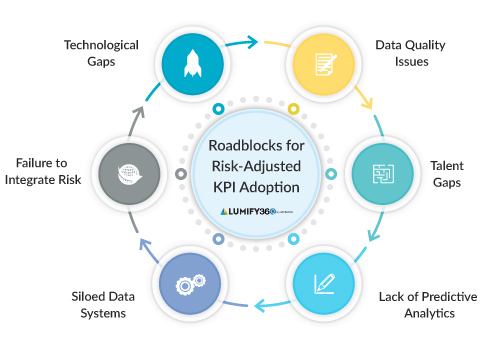
- Data Quality Issues: Inaccurate or incomplete data is a significant barrier to implementing KRI-informed KPIs. Poor data quality leads to unreliable metrics, undermining the credibility of risk-adjusted KPIs. This often stems from inconsistent data sources or outdated information.
- Talent Gaps: A shortage of skilled professionals in risk management and data analytics can hinder the adoption of risk-adjusted KPIs. Without the right talent to manage data analytics and automation, organizations struggle to implement and utilize these metrics effectively.
- Lack of Predictive Analytics: Without predictive analytics, KPIs remain backward-looking, offering only a historical view of performance. This limits a company’s ability to forecast future trends and makes proactive, data-driven decisions more challenging for executives.
- Siloed Data Systems: KPIs are often scattered across different departmental systems—CRMs, marketing platforms, ERPs, and accounting tools—making data consolidation difficult. Even when businesses manage to aggregate this data, it often becomes outdated quickly, limiting its value for decision-makers.
- Failure to Integrate Risk: Many organizations neglect integrating Key Risk Indicators (KRIs) into their performance metrics. Without risk-adjusted KPIs, businesses lack a comprehensive view of future performance. KRIs are often tracked in isolated systems, like spreadsheets or ERM platforms, which aren’t connected to KPIs, hindering a unified risk-performance analysis.
- Technological Gaps: Mid-market companies often lack the technological infrastructure for real-time predictive KPI insights. While larger enterprises have the resources to implement data warehouses and lakes, mid-sized businesses face challenges in setting up the necessary systems to create dynamic dashboards and reports.
Solutions and Mitigations for Risk-Adjusted KPIs
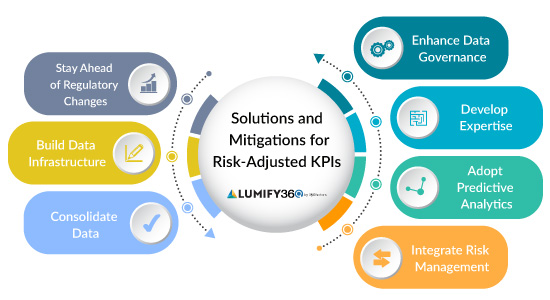
- Enhance Data Governance: Implement a robust framework to ensure data accuracy, consistency, and completeness. Conduct regular audits and assign data stewards to oversee data quality and processes, ensuring the long-term reliability of KPI metrics.
- Develop Expertise: Invest in training programs to build in-house expertise in risk management and data analytics. Temporary external consultants or educational partnerships can provide specialized skills, but continuous employee development is key to sustainable growth.
- Adopt Predictive Analytics: Leverage predictive analytics tools to move beyond backward-looking KPIs. These tools help forecast future trends and risks, enabling businesses to make proactive, data-driven decisions.
- Integrate Risk Management: Link KPI systems with risk management platforms like ERM and GRC software to ensure risk factors are automatically factored into performance assessments. This integration supports a more comprehensive, risk-adjusted view of performance.
- Consolidate Data: Invest in data integration platforms that consolidate information from disparate sources, such as CRMs, ERPs, and marketing systems, into unified dashboards. This reduces manual efforts and ensures decision-makers have real-time, accurate data for analysis.
- Build Data Infrastructure: Mid-sized businesses should prioritize investment in data warehouses and lakes to enable real-time KPI tracking and visualization. External partnerships can help alleviate resource constraints when building or managing this infrastructure.
- Stay Ahead of Regulatory Changes: Establish a team or appoint a dedicated role to monitor regulatory developments and ensure that KPIs align with compliance requirements. This proactive approach ensures that businesses stay ahead of changing regulations while maintaining effective performance management.
Conclusion
For mid-sized organizations navigating today’s dynamic markets, implementing risk-adjusted KPIs is no longer optional—it’s essential. This guide has outlined the key principles, methodologies, and best practices that can help businesses integrate risk-adjusted KPIs into their performance management strategies effectively.
Key Takeaways:
- Strategic Alignment: Risk-adjusted KPIs must be tightly aligned with your organization’s strategic objectives. This alignment ensures a holistic approach to performance measurement and risk management, resulting in more informed and impactful decision-making.
- Comprehensive Risk Assessment: It’s crucial to regularly evaluate a broad spectrum of risks—credit, market, operational, and compliance—within your KPI framework. A comprehensive risk assessment gives a clearer and more resilient picture of your organization’s performance.
- Embrace Technology: Leveraging advanced tools such as AI-powered platforms and data analytics is key to enhancing the accuracy and timeliness of risk-adjusted KPIs. Real-time insights allow businesses to identify emerging risks and trends, facilitating proactive decision-making.
- Cultivate a Risk-Aware Culture: Encourage a risk-aware culture across the organization by providing education and clear communication on risk-based performance improvement. Engaging employees fosters collective accountability and strengthens the organization’s commitment to success.
- Continuous Monitoring and Adaptation: Regularly revisit and refine your KPIs to reflect evolving market conditions, business goals, and the risk landscape. An adaptive KPI strategy ensures that performance goals remain relevant and actionable in changing environments.
By adopting these strategies, mid-sized businesses can effectively manage risk while driving performance to achieve their strategic goals. Risk-adjusted KPIs provide a comprehensive view of performance, empowering organizations to respond to market volatility, strengthen competitive advantage, and promote sustainable long-term growth.
Lumify360 offers an integrated solution for businesses transitioning to risk-adjusted KPIs, combining data analytics, AI automation, and risk management into a single platform to enhance decision-making and performance outcomes. Explore Lumify360.
